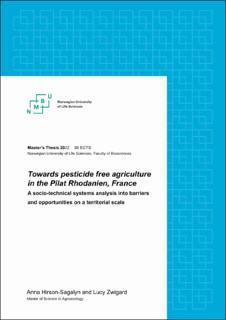| dc.contributor.advisor | Morse, Suzanne | |
| dc.contributor.advisor | Celette, Florian | |
| dc.contributor.advisor | Brives, Hélène | |
| dc.contributor.author | Hirson-Sagalyn, Anna Nadya Suzanne | |
| dc.contributor.author | Zwigard, Lucy Hannah | |
| dc.coverage.spatial | France, Pilat Rhodanien | en_US |
| dc.date.accessioned | 2023-01-26T13:36:15Z | |
| dc.date.available | 2023-01-26T13:36:15Z | |
| dc.date.issued | 2022 | |
| dc.identifier.uri | https://hdl.handle.net/11250/3046633 | |
| dc.description.abstract | This research was conducted as part of the first phase of a 6-year long project run by INRAE called “Be Creative” (2021-2026). The project’s ambition is to study specific agricultural territories in France in view of designing initiatives with local inhabitants, farmers and other territorial actors for the realization of zero-pesticide agricultural systems. Our territory of study was the Pilat Rhodanien, a geographical zone along the west side of the Rhône river valley, south of Lyon. We investigated viticulture, a prominent and historic production on the plateaus and steep hillsides of this peri-urban landscape. Our goal was to understand the influences on chemical input use in these vineyards through qualitative ethnographic research. This was followed by multi-scalar, thematic analyses using the multi-level perspective on socio-technical transitions, actor network mapping and stakeholder management strategy, which we enriched using a political ecology lens. Our findings center on barriers and opportunities to reduce the use of chemical inputs, notably herbicides and fungicides. The socio-technical lock-ins that we found to be maintaining the use of chemical inputs were multifaceted. We highlight the role of social networks, norms, values, knowledge systems and practices held by the historic, familial and deeply-embedded productions characterized by prestigious geographical indications. We identified actors in these social networks who play diverse roles in the territory related to chemical input use and reduction, their participation and activities being key aspects of agroecological transition processes in the territory. We forecast the next phase of the Be Creative research project, by proposing potential innovations that may further help reduce and/or eliminate pesticide use in the vineyards of the Pilat Rhodanien, many of which rest on multi-actor collaborations. | en_US |
| dc.description.sponsorship | INRAE ; Parc Naturel Régional du Pilat ; NMBU Biovit småforskmidler | en_US |
| dc.language.iso | eng | en_US |
| dc.publisher | Norwegian University of Life Sciences, Ås | en_US |
| dc.rights | Attribution-NonCommercial-NoDerivatives 4.0 Internasjonal | * |
| dc.rights.uri | http://creativecommons.org/licenses/by-nc-nd/4.0/deed.no | * |
| dc.subject | Agroecology | en_US |
| dc.subject | Pesticides | en_US |
| dc.subject | Socio-technical systems | en_US |
| dc.subject | Socio-technical lock-in | en_US |
| dc.subject | Multi-level perspective | en_US |
| dc.subject | Territorial scale | en_US |
| dc.subject | Pilat, France | en_US |
| dc.subject | Political ecology | en_US |
| dc.subject | Actor network | en_US |
| dc.subject | AOC | en_US |
| dc.subject | Viticulture | en_US |
| dc.title | Towards pesticide free agriculture in the Pilat Rhodanien, France : a socio-technical systems analysis into barriers and opportunities on a territorial scale | en_US |
| dc.type | Master thesis | en_US |
| dc.description.version | submittedVersion | en_US |
| dc.subject.nsi | VDP::Agriculture and fishery disciplines: 900 | en_US |
| dc.description.localcode | M-AE | en_US |

